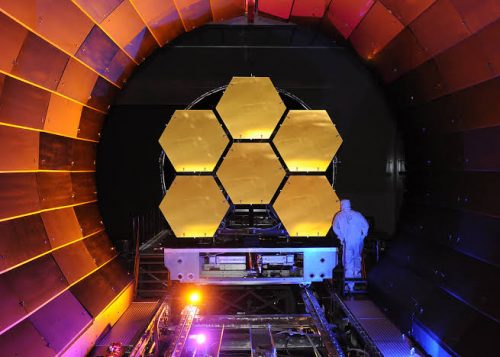NASA’s James Webb Space Telescope, the world’s largest space scientific telescope, was launched into orbit on December 22, 2021.
It is equipped with four powerful scientific instruments along with massive mirrors and reflectors which will collect light reflecting from deep space objects.
These mirrors will play a vital role in capturing high-resolution images and will help researchers in analysing deep into history of the universe.
Significance Of The JWST Mirrors
A huge mirror, which will help collect light from the objects being examined, is one of the most crucial items it will carry. The Webb Telescope team has created a mirror that can fold up and fit inside a rocket before unfolding in space.
The James Webb Space Telescope is folded to fit inside its rocket. After launch, it must slowly unfold itself, step by step, as it makes its way through space.
The Structure Of The JWST Primary Mirror
The primary mirror is made up of 18 hexagonal-shaped mirror parts with a diameter of 1.32 meters that are placed together in a honeycomb pattern.
It will have a 6.5 meters diameter when fully opened. The mirror on the Hubble Space Telescope was just 2.4 meters in diameter.
“The primary mirror is an engineering wonder.” When fully deployed, the lightweight mirrors, coatings, actuators and mechanisms, electronics, and thermal blankets make a single exact mirror that is simply astounding,” said Lee Feinberg, optical telescope element manager for Webb at NASA’s Goddard Space Flight Center in Greenbelt, Maryland.
Why is Beryllium Used In The Mirrors?
Each mirror piece is composed of beryllium and weighs about 20 kg. According to NASA, beryllium was chosen because this element is both powerful and light.
“Beryllium is exceptionally robust for its weight and holds its shape well across a wide temperature range. Beryllium is a nonmagnetic metal that conducts electricity and heat well.”
“Beryllium is frequently used to create parts for supersonic flights and the Space Shuttle because it is light and strong,” according to the agency.”
It further said that particular precautions were taken when working with beryllium because inhaling or swallowing beryllium dust is harmful.
Why Is Gold Used For Plating The Beryllium Mirrors?
It does. After polishing the beryllium mirror segments, a thin layer of gold was added. Gold improves the mirror’s infrared light reflection.
A process known as vacuum vapor deposition was used to cover the gold. A small amount of gold is vaporized and deposited on the mirrors while they are held in a vacuum chamber.
The gold has a thickness of only 100 nanometers. As a result, the mirror was made with less than 50 grams of gold. To protect the gold coating from scratches, a thin layer of glass was also put on top of it.
Why Are Mirrors Shaped Hexagonal?
A nearly circular, segmented mirror with “excellent filling factor and six-fold symmetry” is possible because of the hexagonal shape. The parts have a high filling factor, which means they fit together perfectly. Gaps would exist between the segments if they were circular.
Symmetry is advantageous since only three different optical prescriptions are required for the 18 segments, six of which must be identical (see above right diagram).
Finally, because the light is focused into the most compact region on the detectors, an approximate circular overall mirror shape is preferred. Images would be extended in one direction if viewed through an oval mirror, for example. A square mirror would reflect a significant amount of light away from the center.
